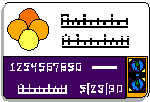P.O.Box 388, Tirat-Carmel, Israel
voice: +972-4-8576982 fax: +972-4-8576983

| Aurora
Technologies Ltd. P.O.Box 388, Tirat-Carmel, Israel voice: +972-4-8576982 fax: +972-4-8576983 |
 |
| Projects and Installed Systems |
Electronic Terminal and Smart Card Activity Profile
SMART CARD APPLICATIONS - A GENERAL OVERVIEW
Aurora Technologies has been actively involved in a large number of smart card applications in Israel. We have, In fact, the largest and most diverse installed base of applications in that country todate. Of these, there are several main projects which have been designed, developed and activated. These are the University of Bar-Ilan Electronic Purse, the Tel-Aviv University Electronic Purse, the Monitax taxi card, the Airport Authority Employee Smart Card scheme, access control systems and the Army Personnel File and Achievement Record program.
In all of the applications described, our involvement was global and comprehensive. It included the system specification, definition and design, through hardware and component specification, software design and development, all aspects of the smart card structure and access and, finally, system integration and testing.
In the process of developing the various applications described below, we have had the need and opportunity to exercise a great number of readers and terminals and different types of smart cards from diverse vendors, including contact and contactless cards. We have, for example, developed applications using terminals and readers manufactured by Thyron (Financer), Schlumberger (Magic 3000, Magic 9000, Reflex and others), Ingenico (Elite series), Aladdin, Fortress, Fischer International (SMARTY), IBM, etc. In most of the applications, we have had to utilize most of the various features provided by the terminals, such as reading and writing smart cards, accessing magnetic cards, display and printer manipulation, modem and serial communications activation and processing and other firmware functionalities up to and including interrupt based functions.
| The University of Bar-Ilan Electronic Purse |  |
The Smart Card program in the Bar-Ilan University was a pilot program designed to implement a classical electronic purse scheme in a controlled and well defined environment. The smart cards were sold to the student body for use in various vending machines, telephones and services, as a replacement for cash. A card is recharged multiple times at charging satellites. The project included several activity centers and a variety of modules:
The smart card based
electronic purse scheme involves several levels of protection and
integrity. These include administrative measures and
security measures.
The administrative elements involve a closed knit monetary system which supervises and accounts for all moneys “charged” into the cards versus all moneys expended by the service providers. A daily transaction information collection and accounting system monitors the cash flow, and can pinpoint irregularities down to the individual card or vending machine.
The security measures are based on the secrecy of the card structure and of the secret keys involved in performing monetary transactions. These measures are built into the basic card characteristics and employed by the dedicated application software.
Todate, the Bar-Ilan Electronic Purse has been fully active for well over a year. It is, in fact, one of the larger electronic purse schemes worldwide, with over 17,000 cards in circulation, and typically 60,000 transactions per month.
The Tel-Aviv University Electronic Purse
The Tel-Aviv University Electronic Purse was launched in November, 1997. The Purse scheme in its entirety was designed and developed at Aurora, and included sophisticated encryption/decryption tools and innovative key management techniques.
As in the Bar-Ilan program, the Tel-Aviv University project included several activity centers and a variety of modules:
Aurora Technologies designed and wrote several application implementing software programs in the end units, which included:
The transaction data in the remotely located end units is downloaded periodically to a PC. During the downloading session, the PC updates the list of blacklisted cards in the stations, and values of special functional parameters essential to the stations (price lists, allowed debit limits, etc.). The communication software is proprietary and was designed and developed at Aurora.
The smart card based electronic purse scheme involves several levels of protection and integrity. These include administrative measures and security measures.
The administrative elements involve a closed knit monetary system which supervises and accounts for all moneys “charged” into the cards versus all moneys expended by the service providers. A daily transaction information collection and accounting system monitors the cash flow, and can pinpoint irregularities down to the individual card or vending machine.
The security measures are based on the secrecy of the card structure, on the secret keys involved in performing monetary transactions and on the encryption techniques applied. These measures are built into the basic card characteristics and employed by the dedicated application software in the end units.
During the first two weeks of activity, over 16,000 cards were sold. Todate, there are more than 40,000 cards distributed and used daily. On an average day over 8,000 transactions are carried out, providing well over 200,000 transactions per month!
The Tel-Aviv University Electronic Purse has been duplicated in an additional two campuses in Israel. In one of these, the EP functionality has been expanded to include personal identification and information, and is used as a personal Student ID Card.
| Army Personnel and Achievement Record Program |  |
This program was initiated by the military authorities as a pilot for a flexible and transportable medium to retain and transport personal information of enlisted personnel. The medium selected was a smart card. The card provided ample memory space for registering the necessary information, as well as a protected environment which would be inaccessible to unauthorized elements.
The Personal Smart Card contained identification information relating to the soldier. It also included data pertaining to his military training and accomplishments, courses he had passed and current training achievements.
The program was designed around a system which included, in addition to the smart cards and their readers, a host of laptop computers for accumulating and updating the information data base, and a central command computer. The data was processed and retained in this central command computer. The database software was based on the Magic package.
The Army Personnel and
Achievement Record Program is a typical application oriented
towards personal identification and variable personal data
located on one medium. It can be applied in many similar
functionalities, such as medical records, academic achievement
records, etc.
Monitax Taxi Card
![]()
The Monitax card is intended for use by taxi companies who cater to regular customers. It is similar in application to the use of multiple-use tickets in public transportation.
The Monitax card includes a decrementable counter which is preset to the number of rides paid for by the owner of the card. It is an non-personal card. In addition to the basic count-down function, the card includes a small amount of descriptive information that can be varied, such as the value of a unit count. In order to reduce prices, cheap telephone cards were used. A special and proprietary scheme recycled the cards to reduce expenditures even further.
The Monitax system
includes a central office to which daily transactions are
transferred from the individual taxi cabs and which issues the
new and recycled cards.
Airport
Authority Employee Smart Card Scheme |
 |
The Airport Authority smart card scheme is a comprehensand complex system. It was designed to allow the thousands of employees and contractors, which work for the Authority in numerous locations, to use the dining facilities at several dozen restaurants. These restaurants are contracted to the Authority by various remuneration schemes.
The program involved the use of several different types of smart cards, from different manufacturers, with a host of different card readers. Each restaurant has several card readers installed. All report to the central administration office.
The scheme included several charging stations, located at distant and some at remote locations. It is comprised of a complex system of restaurant pricing and employee privileges. The application had to implement these at each terminal and the central administration computer had to integrate them into the daily and monthly reports and accounts.
As in the electronic purse
schemes, the Airport Authority project had to be resistant to
counterfeiting and misuse of the cards. The cards
were issued on a personal basis, and include options for future
additional applications (e.g. access control and parking control)
and expansion of the existing functionality.
| Biometric Access Control |  |
The smart card has been integrated into a biometric access control system. The system is based on a hand-reading unit. This unit performs personal recognition by means of a biometric reading of a person’s hand.
The biometric signature of authorized personnel has been written onto a smart card. Upon entry, the person places the smart card into the card reader and is then prompted to place his hand on the handreader. If the biometric signature of the handreader matches that which is written on the smart card, the entry door or gate are opened to allow entry.
The system includes, in
addition to the physical access control, a time and attendance
software package for personnel management.
Smart Card Based Access Control System
For access control
locations that do not require biometric identification, a simpler
system has been developed. This system is based on smart
card readers, placed at the points of entry, which communicate on-line
or off-line with the central (PC) computer. The smart cards
have the employee’s picture and name, and serve as a
personal badge. The card may also include additional
pertinent information, such as allowed access times, conditional
entry restrictions and employee privileges.
CREDIT AND DEBIT CARD APPLICATIONS
Shva Ashra’it ’96
Certification Programs 
Aurora Technologies has written applications complying with the Shva Ashra’it ’96 Specification. Todate, these applications have been installed and certified on Electronic Transaction Terminals produced by two leading manufacturers, Schlumberger and Ingenico.
Shva is an organization representing a consortium of the banks in Israel. It is Israel’s credit card central transaction service provider, and all credit card transactions pass through it. Shva has issued its’ latest version of the terminal specification. This specification is called Ashra’it ’96. All new terminals and POS units in Israel must conform to this specification. The latest version was released on January, 1998, and there have been several updates since.
The Ashra’it ’96 specification essentially deals with 5 main issues relating to the credit card transactions. These are:
The specification is quite
complex, as it deals with all of the local as well as the
international credit card schemes. Aurora is very
experienced and versed with the Ashra’it ’96
specification. We have implemented programs that implement
the specification on several platforms.
In all cases,
the complete program was written in Aurora in the development
environment native to the particular terminal platform. It
was adapted and optimized to the terminal, and underwent rigorous
testing covering the wide range of credit cards supported by Shva
and communications with the Shva Transaction Server. The
applications included file and data processing and operator menu
and interaction systems.
SUMMARY
| From the cases described above, it is evident that experience and expertise found in Aurora Technologies, relating to Smart Cards and Electronic Transaction and POS Terminals, is outstanding. |  |
| home | profile | products | projects | partners | press release | contact us | smart cards | credit cards | POS terminals |
Aurora Technologies Ltd.
P.O.Box
388, Tirat-Carmel 30200, Israel
Tel:
(+972)-4-8576982, FAX: (+972)-4-8576983
e-mail:
[email protected]